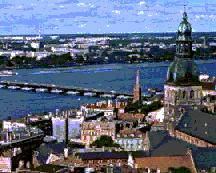 Latvians
are sometimes too busy with their independence to remember that they cannot avoid
the original unity of Baltic and Slavic languages. Latvians or Letts were
mentioned already by Herodot and some other historians, they are representatives
of those of Baltic tribes who moved north from Neman, in order to settle
on the lands of Finno-Ugric Estic tribes. Though Latvians were never independent
until 1918, occupied by Teutonic knights, Polish and Swedish invaders,
then by Russian Empire, the language managed to survive everywhere and
is a state language now.
Latvians
are sometimes too busy with their independence to remember that they cannot avoid
the original unity of Baltic and Slavic languages. Latvians or Letts were
mentioned already by Herodot and some other historians, they are representatives
of those of Baltic tribes who moved north from Neman, in order to settle
on the lands of Finno-Ugric Estic tribes. Though Latvians were never independent
until 1918, occupied by Teutonic knights, Polish and Swedish invaders,
then by Russian Empire, the language managed to survive everywhere and
is a state language now.
Latvian is closely related to the Lithuanian language, but is the less conservative of the two, showing numerous sound changes in its historical development. Latvian has short vowels and monophthongs in the final syllables of words where Lithuanian has long vowels and diphthongs. The pronounciation in Latvian, comparing to Lithuanian, is much more "germanized" and acquired even Finnish features. Grammatically, Latvian, like Lithuanian, is a highly inflected language, having seven noun cases and six verb declensions.
The earliest printed writings in Latvian are religious in nature: a Roman Catholic catechism (1585), a Lutheran version (1586), and a translation of the Bible (1685). In the 19th century a modern literary language developed, based on the Central Latvian dialect. Two other major dialects exist: West Latvian (also called Livonian, or Tahmian; See Also Finno-Ugric Languages) and East Latvian (High Latvian). First written in Gothic script, the Latvian language has used the Roman alphabet with diacritical marks since 1922.
There are some resources on Latvian language on the Web you can see.
For more interest in Baltic linguistics, see our Indo-European
Grammars.